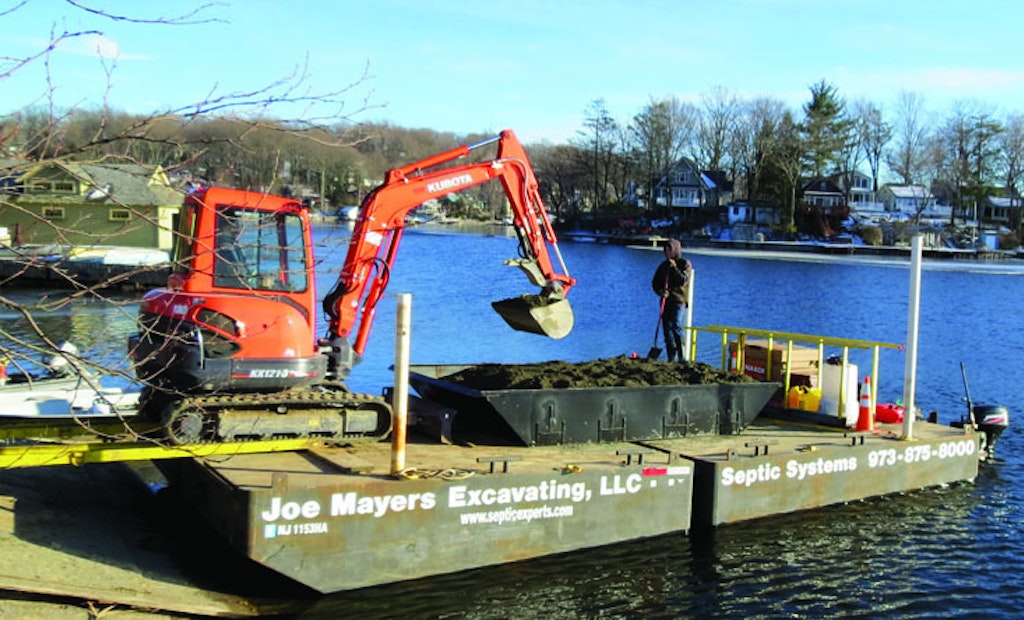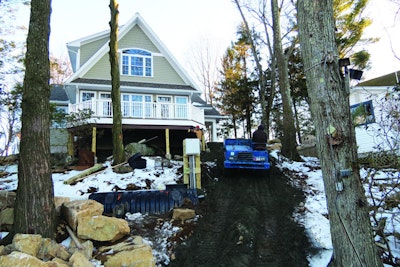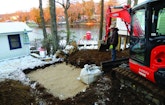
Interested in Septic Tanks?
Get Septic Tanks articles, news and videos right in your inbox! Sign up now.
Septic Tanks + Get Alerts
Owners of a 147- by 126-foot-wide lot on Raccoon Island in Lake Hopatcong, N.J., wanted to renovate their two-bedroom seasonal home and needed to upgrade the onsite system. The general contractor recommended Joe Mayers, proprietor of Septic Experts in Sussex, N.J. He worked with Howard Bach, P.E., of Sparta, N.J., to design the system.
“Besides limited space, the lot was accessible only by boat and the elevation rose 20 feet in the 56 feet from the beach to the house,” says Mayers. “Shallow soils, an exposed ledge, and distances to structures ruled out a drainfield.”
Bach chose the Puraflo peat fiber biofilter with subsurface disposal from Anua. “These systems produce Class 1 effluent, allowing us to obtain a reduction in the disposal area and meet the property’s physical constraints,” Mayers says. “Furthermore, when the home is vacant for extended periods, microorganisms living on the media go dormant, but they reactivate to optimal performance levels shortly after the owners return.”
Mayers raced against winter, gambling that he could finish the installation before his barge and equipment became locked in ice.
Site conditions
Soils are 6 to 30 inches of sandy loam with percolation rates of 2 to 6 inches per hour. The island, 200 yards from the mainland, has a seawall.
System components
Bach designed the system to handle 350 gpd. Major components are:
- 1,000-gallon single-compartment IM Series polypropylene septic tank with ML3-932 effluent filter (Bear Onsite). Tanks are made by Infiltrator Systems.
- 1,000-gallon single-compartment polypropylene dose tank with two Goulds 3885 WE0511H 1/2 hp submersible effluent pumps
- Two 150 gpd Puraflo modules with the right unit 12 inches higher than the left
- Dual simplex timer-based control panel with auto-dialer from American Manufacturing Co.
System operation
Wastewater flows by gravity through a 4-inch Schedule 40 PVC lateral 45 feet to the septic tank, then to the dose tank. Every 90 minutes, the alternating pumps send 8 gallons through a 2-inch Schedule 40 PVC force main to the tops of the biofilters. Pump 1 runs for 70 seconds at 14 gpm, sending liquid 48 feet to the right module (Bed No. 1). Pump 2 runs for 59 seconds at 15 gpm, sending effluent 40 feet to the left module (Bed No. 2). “The dose tank will store peak flows until the pumps time-dose them,” says Mayers.
In the modules, effluent trickles through 30 inches of packed peat fiber with a retention time of 48 hours, then drains through 1-inch weep holes along the bottom of the sides into 6 inches of 3/4-inch crushed stone above 10- by 8-foot-wide bank run (sand and gravel mixture) absorption beds.
“Peat fiber has a high lignin content that doubles its life expectancy,” says Mayers. “It also polishes effluent to an average of less than 10 mg/L TSS and BOD, less than 5 mg/L ammonia, and reduces 99 percent of fecal coliforms with no pathogens.”
Installation
Bill Post and Avery Jinks of Septic Experts drove the rubber-tracked equipment over 14-foot-long, 700-pound steel ramps onto a 30- by 16- by 4-foot-high barge weighing 18 tons and powered by two four-stroke 25 hp outboard motors. They loaded a 6-foot-wide, 6.5-ton Kubota 057 excavator, a 5-foot-wide Yanmar 1.15-cubic-yard C30 mini dump truck, and an IHI 1.3-cubic-yard IC30 crawler carrier.
After motoring across the lake, the crew moored by the seawall alongside the homeowners’ dock and reversed the loading procedure. The original design located the tanks on the left side of the house with the two modules in series by the right front corner of the home. As Post lowered the excavator bucket into the soil to excavate the holes, the teeth hit ledge rock at 6 inches. “We were in serious trouble,” Mayers says. “Ledge rock is a type of granite: very hard, smooth and unrippable.”
Bach and Mayers resolved the situation by scrapping the original plan and starting over. They set the modules one on either side of the house and moved the septic tank, dose tank, and control panel 12 feet down the slope toward the lake and centered with the home. Shifting the components also changed the pump requirements.
Post stockpiled the multiple boulders he found while excavating the holes. “Our code requires replacing existing soils with select fill,” says Mayers. “Besides building the absorption beds, we needed additional backfill to replace the space occupied by boulders. Every scoop came by barge. It was a time-consuming process.”
A standard dump truck offloaded into a 14- by 7- by 2-foot-high containment pan on the mainland dock. Using a Kubota 121 excavator, Post filled the bucket, drove along the ramps onto the barge, and placed the material in an identical pan on deck, loading from the stern forward.
Back at the island, Post used the Kubota 057 to offload into the bed of the IHI crawler carrier (the Yanmar was for backup). Jinks drove the carrier up the hill and dumped the material where needed. “The carriers go up and down steep grades and traverse soft or swampy land with minimal damage to the terrain,” says Mayers. Gravel and bank run were transported in bags.
The men covered the ends of the module excavations facing the house with 20 mil medium-density polyethylene pond liner to prevent effluent from migrating back to the basement. Then they placed and compacted the select fill and gravel, set the units, covered the gravel with filter fabric, and connected the manifolds. Before backfilling, they terraced the areas and built 2-foot-high retaining walls around the beds using the stockpiled boulders.
The 2-inch supply lines from the pump tank to the modules lay in 2-foot-deep trenches. “Water drains back to the tank at the end of a dose cycle, so there is never any liquid in the lines to freeze,” says Mayers.
Except for working on a steep slope, setting the tanks and installing the control panel was straightforward. This area also was terraced and enclosed by a retaining wall. Because the lot didn’t have enough soil to backfill around the house and system, Mayers ferried in four tandem loads of screened fill. He got his equipment off the island and barges out of the lake just days ahead of an Arctic air mass that froze the surface of the lake solid.
Maintenance
Tri-State Pump and Septic Supply in Franklin, N.J., holds the service contract. State code requires a maintenance inspection every six months for the life of the system.








